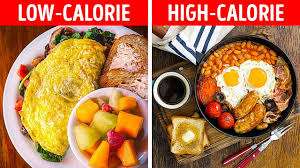High-calorie, low-nutrient foods are often the secret villains behind expanding waistlines and declining health.
From sugary snacks to greasy fast food, these calorie-dense, nutrient-poor choices pack a lot of energy but little nourishment.
This article explores how these foods contribute to obesity, what makes them so irresistible, and how we can turn the tide with healthier choices.
LeanAndFit shall dive into the science, the psychology, and the solutions to this modern epidemic.
Index of What’s Coming Up:
- What Are High-Calorie, Low-Nutrient Foods?
- Why Are These Foods So Popular?
- How Do They Contribute to Obesity?
- Real-Life Example: A Day in the Life of Sarah’s Diet
- The Science: Studies Linking These Foods to Obesity
- FAQs on High-Calorie Low-Nutrient Foods and Obesity
- What Can You Do? Practical Solutions
What Are High-Calorie Low-Nutrient Foods?
Let’s break it down: high-calorie, low-nutrient foods are those that pack a ton of energy (calories) but skimp on the essential nutrients your body actually needs.
They are the culinary equivalent of “all style, no substance.”
Think donuts, chips, soda, and candy bars.
While they might satisfy your taste buds and give you a quick energy spike, they leave your body crying out for vital vitamins, minerals, and fiber.
According to the Journal of Nutrition Science (2020), these foods are typically high in added sugars, unhealthy fats, and sodium, while sorely lacking in key nutrients like vitamins A, C, and D.
This creates a paradox: you are consuming plenty of calories, but your body is still malnourished on a cellular level.
Over time, this imbalance can lead to weight gain and a host of health issues.
Examples Include:
- Sugary Drinks: Soda, sweetened teas, and energy drinks are loaded with sugar and completely devoid of nutrients.
- Processed Snacks: Chips, crackers, and sugary granola bars are high in sodium and unhealthy fats.
- Fast Foods: Burgers, fries, and nutrient-poor pizzas offer plenty of calories but lack nutritional quality.
- Desserts: Ice cream, pastries, and candies provide a sugar rush but little else of value.
These foods may taste great in the moment, but they create a vicious cycle of cravings and nutrient deprivation.
Why Are These Foods So Popular?
If we know these foods are bad for us, why do we find them so irresistible?
Blame your brain! High-calorie, low-nutrient foods are scientifically engineered to hit your taste buds like a party.
According to a study in Cell Metabolism (2018), the perfect combinations of sugar, salt, and fat trigger a dopamine release in your brain.
This feel-good chemical creates a reward cycle, making your body crave more and more. It is not just eating; it is a full-blown neurological event, akin to a short-lived celebration in your mind.
Marketing Influence:
Ever notice how junk food ads pop up during every TV show or while scrolling social media?
That is no accident.
These ads are crafted to tap into your emotions, associating these foods with comfort, joy, and even nostalgia.
A cute jingle here, a happy family there, and suddenly that bag of chips seems like the answer to all your problems.
Convenience and Affordability:
Now, add convenience to the mix.
A burger and fries are cheaper and faster than preparing a balanced meal.
It is a perfect storm of accessibility and affordability that makes healthy alternatives seem like a hassle in comparison.
With such powerful forces working against us, it is no wonder these foods dominate our diets.
The Downside of High-Calorie, Low-Nutrient Foods: A Deeper Dive
- Caloric Overload
High-calorie, low-nutrient foods are energy-dense, meaning they cram a significant number of calories into tiny portions. Think of that burger-and-fries combo from your favorite fast-food joint—it can easily surpass 1,200 calories, over half the daily recommended intake for most adults. Add a sugary soda, and you are looking at a caloric bomb that’s more indulgence than sustenance. This excessive calorie intake creates a perfect storm for weight gain. - Poor Satiety
The problem doesn’t stop with calories. These foods are notorious for their inability to keep you full. Why? They are stripped of fiber and protein, two nutrients vital for satiety. As a result, you are likely to feel hungry soon after eating. Cue the snacking cycle—chips, cookies, or another sugary treat—to satisfy that gnawing hunger, which piles on more unnecessary calories. - Metabolic Havoc
Sugary and processed foods wreak havoc on your metabolism. Sugary snacks cause rapid blood sugar spikes, followed by a crash, leaving you tired and craving more. Over time, this pattern leads to insulin resistance—a key factor in obesity. According to a study in The American Journal of Clinical Nutrition (2020), regular consumption of sugary drinks significantly increases the risk of weight gain and type 2 diabetes.
The trifecta of excessive calories, lack of satiety, and metabolic disruption is why these foods are a major contributor to the obesity epidemic.

A Day in the Life of Diana’s Diet
Sarah, a 32-year-old graphic designer, has a life many can relate to—busy, stressful, and perpetually on the go. Like most of us, she prioritizes deadlines over diet and leans heavily on convenience foods to fuel her day. But let’s take a closer look at how her choices stack up.
Morning Rush: With no time for breakfast at home, Sarah grabs a sugary latte and a muffin on her way to work. While it’s delicious and quick, this combo packs over 500 calories with little to no lasting energy.
Lunchtime Hustle: Between meetings, Sarah orders a fast-food burger and fries because it’s quick and filling—or so she thinks. This meal tips the scale at 1,200 calories, loaded with unhealthy fats and sodium, leaving her lethargic by mid-afternoon.
Afternoon Slump: Feeling drained, she reaches for a candy bar from the office vending machine. The sugar rush feels good—for about 20 minutes. Then comes the crash, leaving her more tired and hungry than before.
Evening Wind-Down: After a long day, Sarah unwinds with pizza and soda in front of Netflix. It’s easy, comforting, and another 1,000 calories.
By bedtime, Sarah has consumed over 3,000 calories—nearly double her daily needs—with little protein, fiber, or essential nutrients. This constant cycle of energy-dense, nutrient-poor meals sets the stage for weight gain, low energy, and a growing health risk. Sarah’s story is a wake-up call for all of us to rethink our “quick fixes.”
>>> Check Out My “Secret Low Calorie Recipe” to “Treat Obesity Naturally” at Home <<<
The Science: Studies Linking These Foods to Obesity
- “Sugar-Sweetened Beverages and Obesity” (The Lancet, 2019):
This study concluded that consuming sugary drinks increases daily caloric intake and contributes to obesity, particularly in children and adolescents. - “Dietary Energy Density and Obesity Risk” (Journal of Nutrition Science, 2021):
Research found that people consuming energy-dense diets are more likely to develop obesity, as these diets encourage overeating. - “Fast Food and BMI” (Obesity Reviews, 2020):
Frequent fast-food consumption was linked to higher body mass index (BMI) and increased fat accumulation.
These studies highlight the direct correlation between high-calorie, low-nutrient foods and rising obesity rates.

What Can You Do? Practical Solutions
The good news is that you can regain control over your diet. Here’s how:
- Choose Nutrient-Dense Foods:
Replace calorie-dense snacks with fruits, vegetables, nuts, and whole grains. For instance, swap chips for roasted chickpeas or soda for sparkling water with lemon. - Plan Your Meals:
Meal prepping can save time and reduce the temptation to grab junk food. Calorie control boosts your metabolism, which in turn helps you lose weight rapidly. - Read Labels:
Be wary of hidden sugars and unhealthy fats in packaged foods. Ingredients like high-fructose corn syrup and hydrogenated oils are red flags. - Practice Mindful Eating:
Pay attention to hunger cues and avoid eating out of boredom or stress. - Educate Yourself:
Understand the nutritional value of foods and aim for a balanced plate with lean proteins, healthy fats, and complex carbs.
FAQs on High-Calorie Low-Nutrient Foods and Obesity
Q-1: Why do high-calorie, low-nutrient (HCLN) foods outcompete whole foods in day-to-day eating?
A-1: They pack more calories per bite with less fiber, water, and protein, so you reach a high energy intake before fullness catches up. Their “hyperpalatable” blends of fat–sugar–salt reduce palate fatigue, making second and third portions unusually easy. In short: faster eating, slower satiation, and a higher “calories per minute” eating rate.
Q-2: How do HCLN foods blunt natural fullness signals?
A-2: Two levers: protein dilution and fiber scarcity. When protein is low, you keep eating to meet your body’s protein target, dragging extra calories along for the ride. Low fiber flattens stretch and gut-hormone feedback, so satiety arrives late. Liquids (sugary drinks, shakes) are the most slippery—quick to consume, weak at triggering fullness, and rarely compensated for later.
Q-3: Do these foods change how the brain responds to food cues?
A-3: Repeated exposure to calorie-dense snacks strengthens cue–reward loops (think: screen time → chips), shrinking the pause between seeing a cue and eating. Over time, you get cue reactivity (stronger urges) and habit learning (automatic reach), which pushes intake above hunger needs—even when meals have already covered energy requirements.
Q-4: If “a calorie is a calorie,” why do HCLN calories lead to more weight gain than the same calories from whole foods?
A-4: In free-living conditions, foods differ in how they shape appetite and pace. Whole foods with higher protein, fiber, and water content slow eating, raise diet-induced thermogenesis slightly, and keep you fuller between meals—so total daily intake drifts lower. HCLN options do the opposite: fast eating, low satiation, and easy snacking between meals, nudging the 24-hour calorie total upward.
Q-5: What are practical ways to displace HCLN foods without strict rules?
A-5: Use the P-F-V rule at each meal—Protein, Fiber, Volume—before any extras. Front-load 20–40 g protein and a high-fiber fruit/veg or legume, then add starch/fats. Engineer the environment: keep HCLN snacks out of line-of-sight, pre-plate portions (no family-style bowls), and cap eating rate by adding fork-down pauses and crunchy produce to every plate. For beverages, swap one sugary drink per day for sparkling water or unsweetened tea; most people save 100–300 kcal without feeling deprived.
Takeaway: HCLN foods tilt the system toward overeating by compressing fullness cues, accelerating eating rate, and strengthening cue-driven habits. Flip the script with meals that prioritize protein, fiber, and volume, plus a few environment tweaks—so total calories fall naturally while satisfaction stays high.
Taking the First Step
While high-calorie, low-nutrient foods are hard to resist, their long-term impact on health is too significant to ignore.
The key is not to eliminate indulgences entirely but to prioritize nutrient-dense options most of the time.
With small, sustainable changes, you can reduce your risk of obesity and build a healthier relationship with food.
Your first step? Swap that sugary latte for a nutrient-packed smoothie. Your body—and your future self—will thank you!
References:
